The Acer Nitro 5 Gaming Laptop Review: Absolutely AMD - Ryzen Plus Polaris
by Brett Howse on February 15, 2019 8:30 AM ESTSystem Performance
Acer offers both Intel and AMD powered versions of the Nitro 5, and there’s some significant differences in terms of CPU options due to the limited product stack AMD launched with Ryzen Mobile. The AMD powered Nitro 5 comes with a Ryzen 5 2500U processor, offering four cores, eight threads, and a maximum boost frequency of 3.6 GHz. Being a U series, the TDP is 15-Watts by default, though AMD offers a range of cTDP modes from 12-25 Watts. This is a rarely tapped feature on most laptops, but in this case it looks like Acer has put the Ryzen in cTDP up mode. We’ve reached out to Acer and AMD to confirm the TDP settings, but as you’ll see below this Ryzen 5 2500U performs well ahead of other we have tested.
AMD has recently announced the second generation Ryzen mobile processors, and the product stack is much wider, with a couple of new H series models which will expand the base TDP to 35 Watts. It would not be a shock to see this Acer updated when those are available.
This is the first Ryzen laptop we’ve tested though that’s been paired with a dGPU, so the Acer’s choice to go with the Ryzen 5 2500U isn’t as large of a step down from the 2700U as usual, since the big jump in the 2700U is the bigger Vega 10 GPU. Since any GPU task will be offloaded to the RX 560X, the iGPU performance tradeoff isn’t a concern.
For comparisons, we’ve included the Dell XPS 15 9560 because it came with a quad-core Kaby Lake and GTX 1050, which is the same type of components found in the other model of Acer Nitro 5. We’ve also included the Surface Book 2 15, which had a 15-Watt CPU paired with a GTX 1060, and the MSI GT75 Titan was included only because it’s the only other laptop we’ve tested with the most recent version of our gaming suite so far. If you’d like to compare the Acer Nitro 5 to any other system we’ve tested, please check out our online Bench.
PCMark
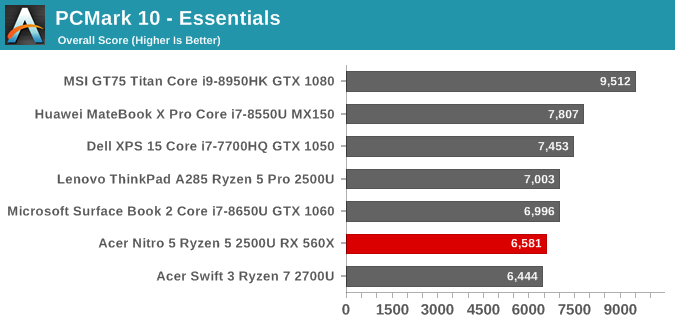
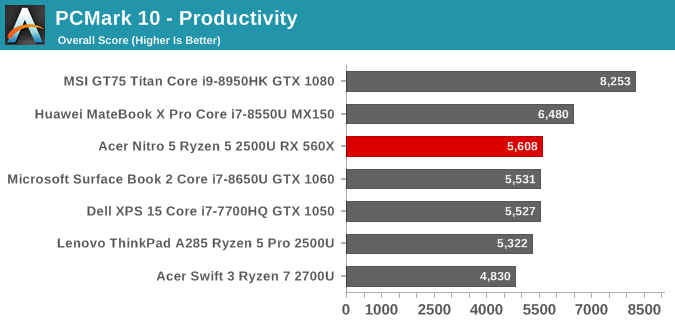
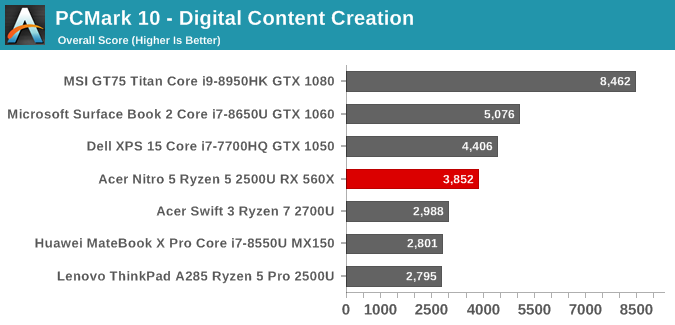
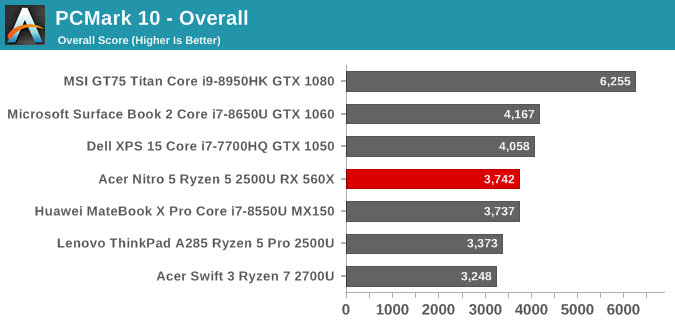
The Nitro 5 holds its own here, performing similarly to the Dell XPS 15, although its not quite able to keep up with a 45-Watt processor in all of the tasks on PCMark 10.
Cinebench
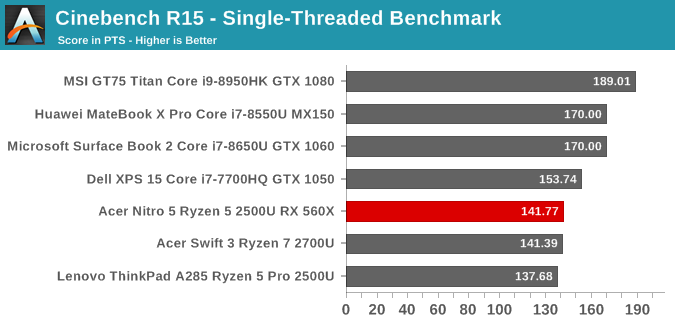
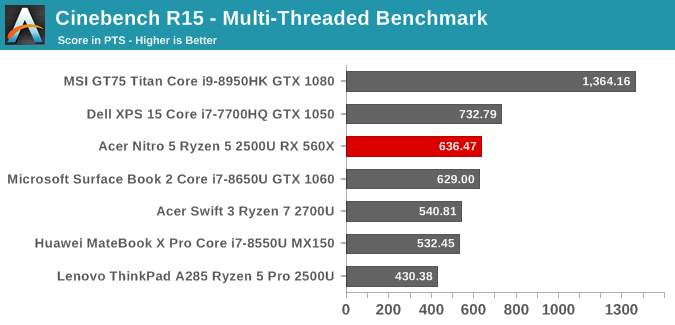
AMD’s Ryzen has always performed well in Cinebench, and continues to here as well. The extra cooling capacity of this gaming laptop lets the Ryzen stretch its legs, outperforming the same Ryzen 5 2500U we tested in the Lenovo ThinkPad A285 by a wide margin.
x264
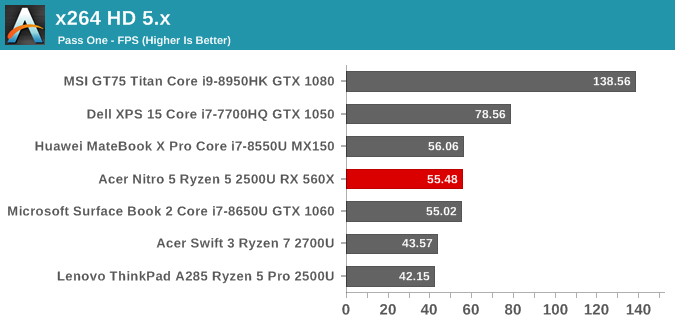
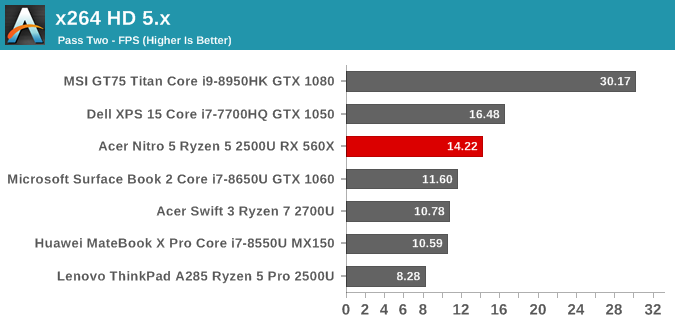
As with the previous tests, the Acer Nitro 5 performs quite well in our CPU based encoding test, but can’t quite match a quad-core Kaby Lake at 45-Watts. It’s still well ahead of the other Ryzen models we’ve tested though.
Web Tests
Web is one of the most important tasks for any system, but is also the least reliable way to check performance, since it is so heavily dependent on the browser, and of course browsers are updated continuously meaning even just using the same browser is more or less a snapshot in time.
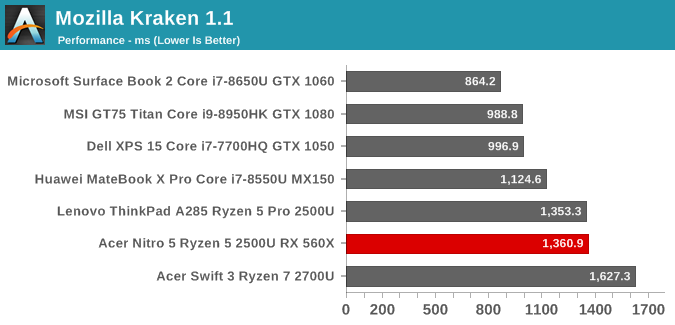

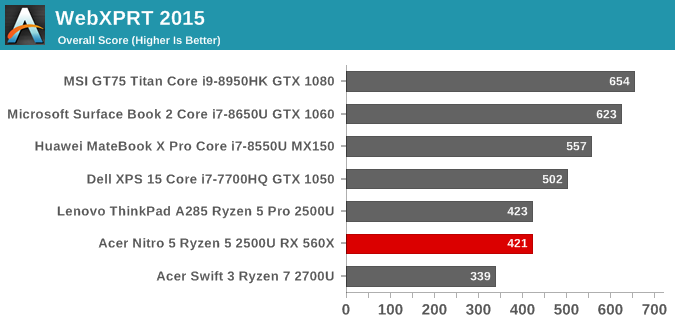
Web performance is one area where Ryzen struggles against the similar Intel Core products, most likely due to the effort Intel has put into their Speed Shift and how quickly the processors can ramp up to their maximum performance level, which is important in web because the tests tend to be short bursts of work.
CPU Conclusion
While not quite able to match the 45-Watt Intel quads, the Acer Nitro 5 with Ryzen 5 2500U still offers very solid performance, offering much more sustained performance than we’ve seen in any previous Ryzen laptop we have tested.
Storage Performance
Unless you buy the lowest-priced Nitro 5, Acer includes SSD storage, as well as a 2.5-inch HDD bay so that you can add extra storage if needed. With a 256 GB OS drive, there’s enough room for the OS and a couple of games though. Acer offers a SATA SSD in the Nitro 5, based on the Micron 1100.
Being a SATA based SSD, peak performance is certainly limited compared to NVMe drives, but it still offers orders of magnitude better performance compared to spinning drives. Considering the budget nature of this device, it’s excellent to even see an SSD, so if it has to be a SATA that is just fine.











90 Comments
View All Comments
Oxford Guy - Saturday, February 16, 2019 - link
Unfortunately, it looks like the ColorMunki's price has gone way up and its software may not be reliable with Windows 10.GreenReaper - Monday, February 18, 2019 - link
It'll probably go on sale at some point and you can buy it then. I never even installed the software, just DisplayCal.Brett Howse - Saturday, February 16, 2019 - link
You can't calibrate when the backlight won't do sRGB. There's no way to get more blue out of the light than is available. All calibration would do is lead to some pretty extensive crushing.Oxford Guy - Sunday, February 17, 2019 - link
I read too quickly and thought you meant the panel had excessive coverage in the blue range. I see that it's the opposite. Usually with cheap laptop screens a very low contrast ratio accompanies strong sRGB undercoverage. A ratio of over 1000 is surprising for a screen with such poor gamut.Some undercoverage of sRGB can still really benefit from calibration, as seen here in the greens:
http://www.tftcentral.co.uk/reviews/viewsonic_vx24...
http://www.tftcentral.co.uk/reviews/asus_ms246h.ht...
http://www.tftcentral.co.uk/reviews/benq_ew2420.ht...
However, if it is severe as this laptop's is, then it's probably not worth the trouble.
GreenReaper - Monday, February 18, 2019 - link
Our eye responds more to green light, so I guess it's one way to easily boost perceived brightness and hence contrast ratios (as long as there isn't too much leakage as well).Calibration makes the crappy TN screen on my Lenovo X120e look a heck of a lot better, even if it's obviously not as good as my other displays - reasonably consistency within its coverage area is key.
Arbie - Friday, February 15, 2019 - link
Saying that one thing is "100% faster" than another means it is twice as fast. You do this repeatedly, where what you meant is "100% as fast". The two are wildly different.Brett Howse - Friday, February 15, 2019 - link
Appreciate the feedback and updating the wording.LMonty - Saturday, February 16, 2019 - link
I'm glad Brett is confident enough to appreciate valid corrections. :) Many tech writers ignore comments like this or even deny them.Brett Howse - Saturday, February 16, 2019 - link
I wrote one thing while meaning another - I always appreciate constructive feedback!nathanddrews - Friday, February 15, 2019 - link
At first glance - looks like decent budget gaming option. Looking closer:1. WTF is up with single-channel AMD notebooks? It literally HALVES APU performance in some games and significantly nerfs most other CPU operations. If you still have access to this laptop, please consider tossing in another stick of RAM.
2. That IPS display *shudder*. At what point does it even matter if it's going to be of such low quality? Also, why not FreeSync?
3. What's up with the 1060 and 1050 on the gaming charts dramatically switching positions? Are there some throttling issues at play?